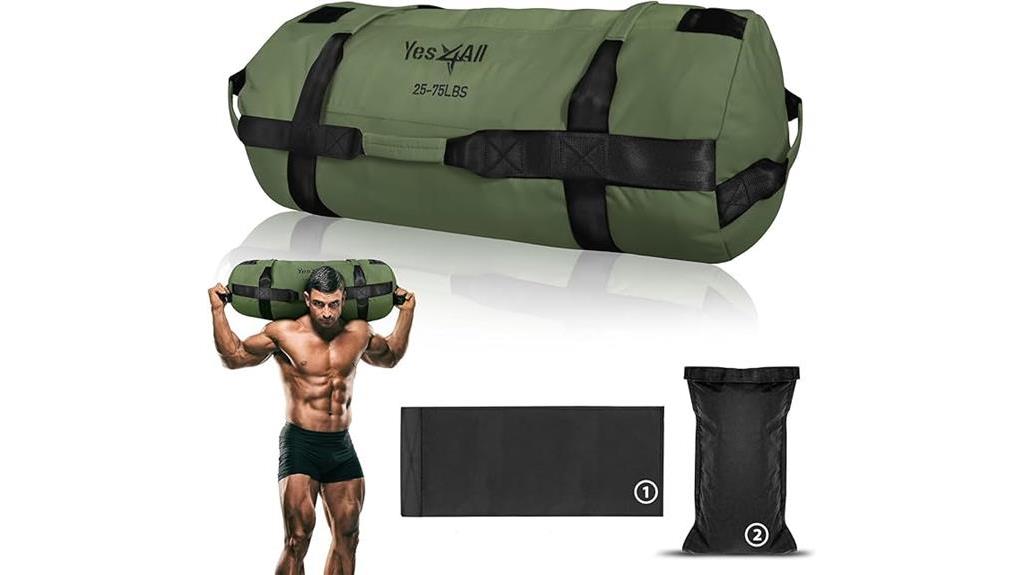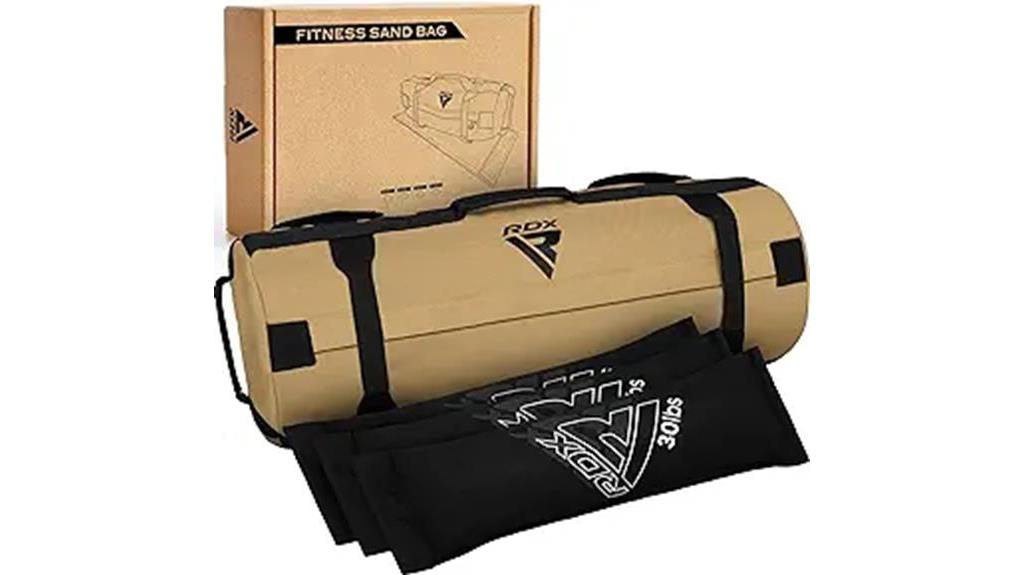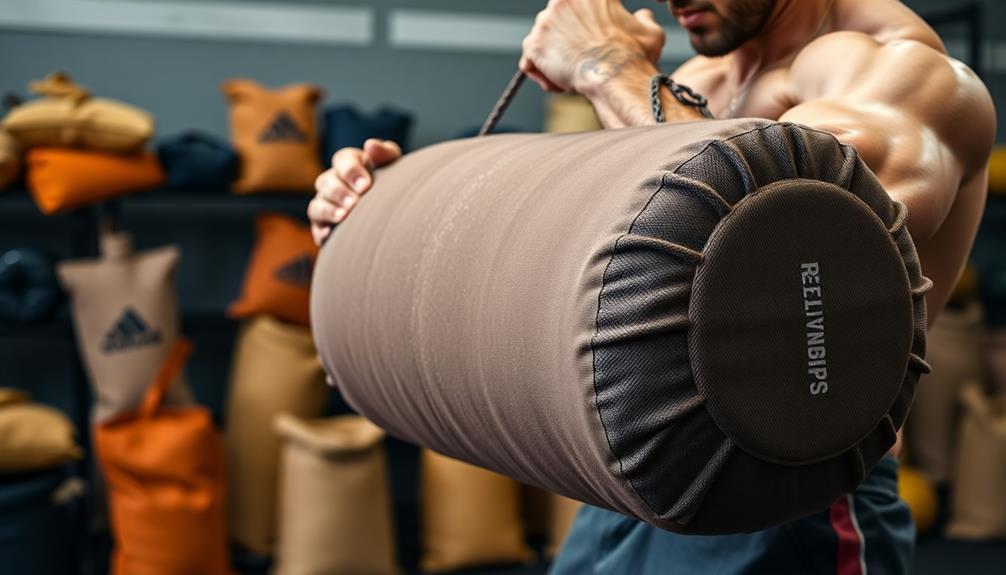If you're looking to add variety and challenge to your strength training routine, sandbags might be just what you need. These versatile tools can help you build functional strength, improve your grip, and enhance your overall fitness. But with so many options on the market, how do you choose the right one for your needs? We've narrowed it down to three top contenders that offer different features and benefits. Whether you're a beginner or a seasoned athlete, there's a sandbag on this list that can take your workouts to the next level. Let's explore what makes these sandbags stand out from the rest.
Yes4All Adjustable Sandbags for Working Out and Weight Training

If you're looking for a flexible and adjustable tool for strength training, Yes4All Adjustable Sandbags are a great option. They come in different sizes and colors, making them a reliable workout partner for everyone, no matter their fitness level. Made from high-quality nylon with a waterproof coating, these sandbags are designed to handle tough workouts.
These sandbags let you easily change the weight by adding or removing sand. The 7-grip design allows you to perform a variety of exercises, like squats and deadlifts, to work different muscle groups. While many users love the quality of these bags, some have mentioned issues with the zippers and inner bags. To get the best results, it's a good idea to start with a smaller size and increase the weight as you get stronger. Despite a few minor concerns, Yes4All Sandbags are still a favored choice for those wanting to boost their strength training routine.
Best For: Anyone looking for a versatile, adjustable strength training tool for full-body workouts and targeted muscle exercises.
Pros:
- Adjustable weight for tailored training
- Multiple grip positions for various exercises
- Durable and waterproof for long-term use
Cons:
- Some users have reported problems with zipper durability and inner bag quality
- Higher-quality options might cost more than other choices
- Filling and adjusting the sandbags can be messy and take time
IronMind Tough-As-Nails Sandbag Set for Strength Training

The IronMind Tough-As-Nails Sandbag Set is perfect for serious strength athletes and strongman competitors. Made in the USA, this sandbag has been a favorite in strongman contests since 2005. It has a 300-pound capacity and is built to last, making it ideal for various exercises, including carries and lifts. You can drop or slam it without worrying about wear and tear.
This set comes with two liners and a training guide, so you can customize your workouts easily. Whether you're into functional training, MMA, or CrossFit, this sandbag will help you build real-world strength. Users have reported notable improvements in their physical fitness and appreciate how easy it is to adjust the weight. Some users mention that the inner liners are a bit thin, but overall, people agree this sandbag set is a cost-effective and durable alternative to traditional weights, suitable for both indoor and outdoor workouts.
Best For: Serious strength athletes, strongman competitors, and fitness enthusiasts who want a versatile, durable, and customizable tool for building strength.
Pros:
- Highly durable, can handle drops and slams without damage
- Versatile for many exercise styles (strongman, MMA, CrossFit)
- Easy to adjust weight for customized training
Cons:
- Inner liners might be thin and could leak
- Grip gloves may be needed for high-rep exercises
- The training guide is basic and may not include detailed workout plans
RDX Unfilled Sandbag for Fitness Training (5-200 lbs)

If you're a fitness enthusiast looking for a strong and reliable sandbag for your workouts, check out the RDX Unfilled Sandbag. This rugged sandbag is made from 1200D Ripstop Cordura Fabric, which means it's built to last, even during your toughest training sessions. You can adjust the weight anywhere from 5 to 200 lbs, making it perfect for a range of exercises like squats and shoulder presses.
The sandbag features eight handles that are placed for easy gripping, allowing you to move it around effortlessly while you train. It has a heavy-duty zipper and double hook and loop closure strips to stop any sand from leaking out, keeping your workout area tidy. While some users have noted stitching issues after heavy use, it generally holds up well for lighter workouts. Plus, you get to fill it yourself, turning it into a fun project on the way to building strength.
Best For: Fitness lovers wanting a flexible, adjustable-weight training tool for home or gym use, especially those focused on functional strength and core workouts.
Pros:
- Made from tough 1200D Ripstop Cordura Fabric
- Adjustable weight range (5-200 lbs) for various exercises
- Eight handles for different grips and exercise options
Cons:
- Arrives unfilled, so you'll need to put in some extra effort to get it ready
- Some users experience stitching durability problems with heavy use
- May take up too much space for those with limited storage options
Factors to Consider When Choosing Sandbags for Strength Training

When you're in the market for strength training sandbags, there's more to evaluate than just picking the heaviest option. You'll want to think about factors like weight capacity range, material durability, handle design, filling options, and portability to guarantee you're getting the best bag for your needs. Let's explore these key points to help you make an informed decision that'll boost your workout routine.
Weight Capacity Range
Choosing the right weight capacity range for sandbags is crucial for effective training. When picking a sandbag, consider a range that suits your current fitness level and future goals. Sandbags typically have a weight capacity range from 5 to 300 lbs, providing plenty of options.
Here's why the weight capacity range is important:
- Versatility: A wider range lets you perform different exercises at various intensities, making your workouts more diverse and challenging.
- Progressive Overload: As you get stronger, you'll need to lift heavier weights to keep making progress. A sandbag with a broad range allows you to gradually increase the load.
- Safety: Choosing the right weight for your level reduces the risk of injury while still challenging your muscles.
- Customization: Adjustable weight options let you tailor the load to your needs, making sandbags a flexible tool for strength training.
Material and Durability
Choosing a sandbag made from strong materials is key for effective strength training. When looking for sandbags, opt for durable fabrics like 1200D Ripstop Cordura or nylon with a waterproof coating. These materials can handle tough workouts, making your purchase worthwhile.
Check the stitching and construction. Look for reinforced X-shaped stitches on the handles and double-layered Velcro compartments. These features help prevent damage, keeping your sandbag in good shape during intense exercises.
If you plan to use your sandbag heavily, pick one designed to endure drops and rough handling. This way, it will stay intact even when you push your limits. Make sure to examine the closure systems and zippers too; strong closures will stop sand from leaking and keep everything secure.
Lastly, think about comfort. Choose materials that won't irritate your skin, as you'll be in close contact with the sandbag. By focusing on durability and comfort, you'll set yourself up for successful strength training sessions that last.
Handle Design Versatility
Choosing the right handle design is crucial for effective sandbag training. When selecting a sandbag for strength workouts, pay attention to how the handles are set up. A good sandbag should have multiple grip options, making it easier and safer to do a variety of exercises.
Aim for sandbags that offer at least 7 different grip positions. This variety allows you to target different muscle groups and stay stable during your movements. For instance, you'll want handles that make it simple to perform squats, lunges, and shoulder presses.
Here are some important factors to consider when looking at handle design:
- Adjustability: Can you easily change grips during your workout?
- Durability: Are the handles strong enough for high-intensity training?
- Comfort: Do the handles provide a secure grip without causing discomfort?
Filling Options Available
When choosing a sandbag for strength training, the filling options are very important. Different materials can be used to fill your sandbag, so think about what works best for you. Most sandbags can be filled with sand, rags, straw, or pea gravel. This lets you customize the weight and feel to match your needs.
Here are some key points to consider when selecting your filling:
- Material Compatibility: Make sure the filling won't damage your sandbag. Avoid using rocky or gravel-filled sand that could harm the bag's interior.
- Weight Range: Sandbags can hold between 5 lbs and over 300 lbs. Choose a weight that fits your strength level and training goals.
- Inner Liners: Check if the sandbag includes strong inner liners. These help prevent leaks and can make your bag last longer.
- Filling Methods: Follow the manufacturer's instructions for filling. Different sandbag sizes may have specific weight ranges for the best performance.
Size and Portability
When choosing sandbags for strength training, size and portability are important factors to consider. Look at the length of the sandbag, which usually ranges from 15 to 24 inches. This size affects how you use the sandbag and how easy it is to store or transport.
Portability is crucial, especially if you plan to use your sandbag for both indoor and outdoor workouts. Opt for lightweight options or those with compact designs. These features make them great for home gyms or taking your workout on the go.
Here are some key points to consider when looking at size and portability:
- Weight range: Pick a sandbag with an adjustable weight range (5-300 lbs) that fits your fitness level and allows you to progress.
- Filling options: Sandbags that can be filled with different materials give you flexibility in weight and make them easier to carry.
- Handle placement: Multiple handles improve maneuverability and simplify transportation.
- Compact design: Choose sandbags that are easy to store or pack when traveling.
Frequently Asked Questions
Can Sandbags Be Used for Cardio Exercises?
Yes, you can definitely use sandbags for cardio exercises. They're versatile tools that'll give you a great workout. Try incorporating them into burpees, lunges, or squats. You'll get your heart rate up and improve your endurance.
How Often Should Sandbags Be Replaced?
You should replace your sandbags when they show signs of wear or leaking. It's not a fixed timeframe, but typically every 6-12 months with regular use. Check them often and replace as needed for safety and effectiveness.
Are There Specific Shoes Recommended for Sandbag Training?
You don't need specific shoes for sandbag training, but opt for sturdy footwear with good traction. Cross-trainers or weightlifting shoes work well. Avoid running shoes, as they lack stability for lifting and carrying heavy sandbags.
Can Sandbags Be Safely Used on All Floor Types?
You can use sandbags on most floor types safely, but take precautions. Place a protective mat underneath to prevent damage. Be careful on slippery surfaces like tiles. Avoid dropping sandbags on delicate flooring to maintain its integrity.
Are There Age Restrictions for Using Sandbags in Strength Training?
You'll find no strict age restrictions for sandbag training. However, you should consider your fitness level and consult a doctor if you're very young, elderly, or have health concerns. Always start with lighter weights and proper form.

